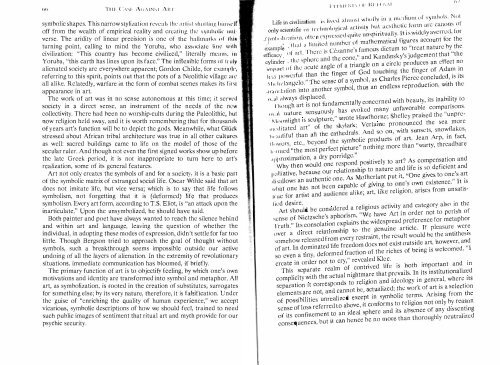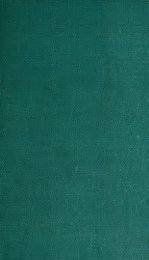CONTENTS - ouroboros ponderosa
CONTENTS - ouroboros ponderosa
CONTENTS - ouroboros ponderosa
You also want an ePaper? Increase the reach of your titles
YUMPU automatically turns print PDFs into web optimized ePapers that Google loves.
hh Ti ll' ( ', \\1 ' ;\ (; .. \ IN,\ I ':\ 1': 1<br />
sym ho I ic sha pes. This narrow s 1 yli za tiOIl revc a Is t II l' a 1 '1 is 1 s! ILl II ill ,I.', II i III "i{'lt '<br />
off from the wealth of empirical reality and creating til l' symboli(' tolli·<br />
verse. The aridity of linear precision is one of the hallmarks 01 Ihl • .<br />
turning point, calling to mind the Yoruba, who assoeiale lillC wllh<br />
civilization: "This country has become civilized," literally mea liS, ill<br />
Yoruba, "this carth has lines upon its facc." The inflexiblc forms 01 Indy<br />
alienatcd society arc everywhere apparcnt; Gordon Childc, for ex""'pit-,<br />
referring to this spirit, points out that thc pots of a Neolithic village arc<br />
all alike. Rclatedly, warfare in the form of combat scenes makes its lirsl<br />
appearance in art.<br />
Thc work of art was in no scnse autonomous at this timc; it serwd<br />
socicty in a direct sensc, an instrument of the necds of the ncw<br />
collectivity. Thcre had been no worship-cults during the Paleolithic, hut<br />
now religion held sway, and it is worth rcmcmbering that for thousands<br />
of years art's function will bc to dcpict thc gods. Meanwhile, what Gliiek<br />
stressed about African tribal architecture was true in all other cultures<br />
as well: sacrcd buildings camc to life on the model of thosc of the<br />
secular ruler. And though not even the first signed works show up before<br />
thc latc Grcek pcriod, it is not inappropriate to turn here to art's<br />
reali z ation, some of its gencral fcaturcs.<br />
Art not only creates the symbols of and for a socicty, it is a basic pan<br />
of thc symbolic matrix of estranged social life. Oscar Wilde said that art<br />
docs not imitate life, but vice versa; which is to say that life follows<br />
symbolism, not forgetting that it is (deformed) life that produces<br />
symbolism. Every art form, according to T.S. Eliot, is "an attack upon the<br />
inarticulate." Upon the unsymbolized , he should have said.<br />
Both painter and poet have always wanted to reach the silence behind<br />
and within art and language, leaving the question of whether the<br />
individual, in adopting these modes of expression, didn't settle for far too<br />
little. Though Bergson tried to approach the goal of thought without<br />
symbols, such a breakthrough seems impossible outside our active<br />
undoing of all the laycrs of alienation. In the extremity of revolutionary<br />
situations, immediate communication has bloomed, if briefly.<br />
The primary function of art is to objectify feeling, by which one's own<br />
motivations and identity are transformed into symbol and metaphor. All<br />
art, as symbolization, is rooted in the creation of substitutcs, surrogates<br />
for something else; by its vcry nature, therefore, it is falsification. Under<br />
the guise of "cnriching the quality of human experience," we accept<br />
vicarious, symholic descriptions of how we should fee I, trained to need<br />
such public images of sentiment that ritual art and myth providc for our<br />
psychic security.<br />
'r ' "<br />
I· t'<br />
Llle Ul elVl lza IOn IS ' .<br />
1 1 1.t\U'NI'" II' Il H I'. \I I , /<br />
- . lived '.lllulsl WlH1UV in a ull·diulli PI' sYIIIllI1b. NIII,<br />
"<br />
" ,.<br />
1 ' t'fi I ' 'hllOlo"irai adivi\y htlt aesthetic ham a.! c (,,1110 s ,<br />
on y sclen IIC (II<br />
.<br />
l<br />
. ,, .<br />
.<br />
n' 01<br />
'uns irituaHv, lt iswiddy avcrrcli, tor<br />
..f i tfll l\ Iii /al inti, nl {" eX'tH I.: s s \d .q u ,tm'lt·tcm a tic l fioures account f or the<br />
example ' . . ' . 'Thcre is Cezanne's famous dictum to .-'trcat nature Y<br />
-- . Ill'll '\ lt1llth:{ IHllll )(':r (, f<br />
_ efficacy<br />
"t ,II I.<br />
cylinder , Il. .<br />
Imp.d " L , .<br />
I, , .) I H ,weI U<br />
II . sphere anu c ,<br />
t · th . ·,cute angle 0 a roa<br />
0 ,<br />
h the<br />
. • th ' cone " and Kandinsky's Judgcment that the<br />
_<br />
t. t ' ngle on a circlc produces an c tect no<br />
f G d touehino the fin ocr of A am m<br />
.1' I than the !mger 0 0 0<br />
" J'l "The sense 0 a sym J<br />
\1" 1,, 1,I"bc o. .<br />
_H:JII:;\ation mto another sym )<br />
"_01 always displaced.<br />
though art IS no u<br />
.<br />
t ··<br />
d<br />
"<br />
.<br />
d . 't<br />
t. . bell as Charlcs Pierce conclude , IS I S<br />
,<br />
' , .<br />
' bol thus an endless reproductIon, WIth the<br />
t f ndamenta Y con<br />
II ccrned wl'th beauty its inability to<br />
. k'd many unfavorable comparisons.<br />
", . .1 "ature sensuou ly<br />
S " :,a; V <br />
l<br />
t a thorne ; Shelley praised the " un pre-<br />
I"onloght IS scu pture,<br />
.<br />
" f<br />
",,·dltated art 0 e<br />
k V I" • pronounced the sea marc<br />
th skyl ar ·· er ame<br />
r...'"ltifu] than all the cat e rabs. .<br />
]<br />
11 1 1wcrs, etc" cyon .<br />
'h d '1' And so on with sunsets, snowtlakes,<br />
-'<br />
d ts 'of art Jean Arp in fact,<br />
b d the sym 0 lC pro uc . ,<br />
. 'd "the most perfect picture no I g<br />
Ii IIllC ,<br />
''1'l 'ro x lm<br />
,<br />
. ation a dry porrodge.<br />
.<br />
"<br />
" th ' n) morc than "warty, threadbare<br />
d 't' I to art" As compensation an<br />
h o ld onc respon pOSI lve y . . ,<br />
Why t en w u<br />
I ,,,lliative, be cause our rc a<br />
1 tionship to nature and life is so deficient an<br />
I · II s an authentIC one. s. (1 ,<br />
I Isa ow,<br />
wloat one has not ee .<br />
.<br />
A ' '!vI therla n t put it "One gives to one's art<br />
•<br />
.<br />
" 1<br />
bl f " g to on"'s e )wn cXlstencc. t IS<br />
b n capa C 0 glvlfl ..... ,<br />
lrue for artist and amilcnce a I e, ar , I<br />
lied desire.<br />
Art should be conSI cr .<br />
sense of Nietzsche's apor : sm,.<br />
I.k ' t rke reiioion arises from unsalls-<br />
0 '<br />
" d cd a religious activity and category also in the<br />
"We have Art in order not to pensh of<br />
the widespread preference for metaphor<br />
Truth." 1Is consolatIon exp al ;; thc enuine artic l e. If pleasure were<br />
over a dlfect relal10nshlp<br />
h eleascd from evcry res ral , .<br />
some ow r<br />
,<br />
t . ';t the result would be the antitheSIS<br />
. freedom docs not exist outside art, however, a.<br />
of art. In domonated<br />
llf<br />
<br />
fraction of the riches of being is wclcomed. '1<br />
d form<br />
d<br />
sO even a uny, e .<br />
,<br />
create on order not to cry,<br />
I d Kl<br />
" revca e cc.<br />
. d rf ' 's hoth important and on<br />
. , . ' te realm of contnve l e t . .' .<br />
ThIS separa<br />
comploclty Wlth the actu<br />
separation It corr e s P JI1 d S tO<br />
elements are not, an canno<br />
.<br />
d<br />
d<br />
.<br />
d<br />
. , . d<br />
, al ni htmare that prevails. 1n its onstltullonahze<br />
.<br />
g<br />
r ' on and ideology in general, where Its<br />
t l ! tuali zcd' the w ;"k of art is a selection<br />
, .<br />
. mblic terms. Arising from the<br />
of possibilities unre c<br />
<br />
f a ; x<br />
e<br />
<br />
v i e f ms to religion not only by reason<br />
sense of loss re erre<br />
'<br />
.d I<br />
f ·t onfinement to an I ea sp ·<br />
o I S C<br />
consequenccs, hut 1t can hence<br />
here and its absence of any dlsscntmg<br />
,<br />
j' d<br />
' . be no more than thoroughly neutra lZe






